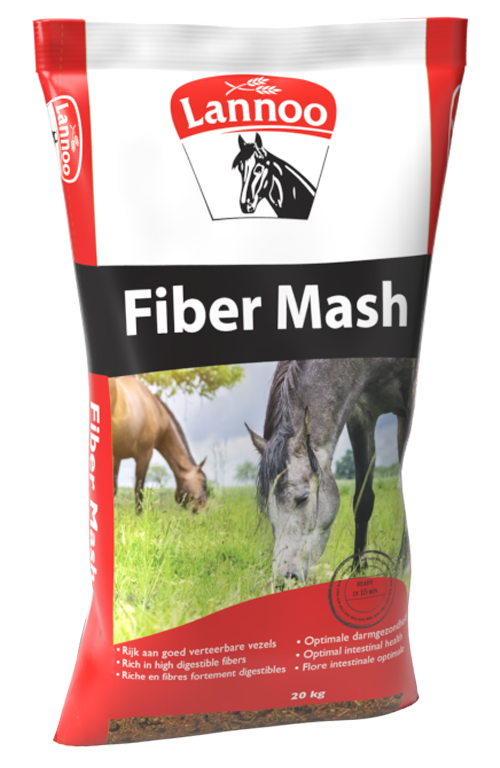
With the end of summer, the grazing season will also soon be completed. This period is known to horse owners as the stabling period. Horses that came to pasture in the spring and spent the summer there are put back in their stalls, usually from day to day, for the winter. This change in housing can cause a number of problems.
There are a number of concerns to consider: The ration change should be controlled. Any feed change should be introduced gradually so as not to upset the horse's digestive system. Over a period of 10 days, stabled horses can gradually be fed more concentrate.
When a horse is always at pasture, an average of 80 kilograms of grass is absorbed. The basis of the ration, when stabled, should also consist mainly of roughage. Good quality, dry hay is the best source of fibre for horses. When choosing hay, assess its colour and smell. If in doubt, a forage analysis can confirm the quality. Specific attention should be paid to dust. Wetting or rinsing can help avoid respiratory allergies. Introducing haylage is best done gradually. Supplementary feeding of hay or haylage on pasture can ease the transition from pasture to stable. When the horse is stabled, hay can continue to be gradually built up over five to 10 days. Either way, make sure your horse can always absorb enough crude fibre.
Lannoo Fiber Mash, provides an appropriate supplement for this. This mash based on alfalfa, linseed, beet pulp and chicory pulp is grain-free, easily digestible, low in sugar and starch and ensures optimal functioning of the intestinal system. During winter, many horses benefit from providing Fiber Mash. The high levels of crude fibre guarantee a sufficient supply of easily digestible fibre, which supports intestinal function, helps the horse maintain its body condition score and, on top of that, helps maintain its thermoregulation. In nature, horses will build up a reserve before winter to get through the cold winter months. During winter, horses will then regain weight due to the extra energy consumption associated with thermoregulation. In horses that tend to lose too much weight in winter, adding vegetable oil to the ration can be a solution to bring in energy in high concentration.
Introducing straw should be done gradually when stabling to avoid colic due to obstruction. The horse can be stabled on a floor of wood shavings and fed a daily portion of straw that is increased daily. The combination with high-quality hay and Fiber Mash, will ensure that transit remains optimal.
Due to reduced exercise, horses in stables sometimes suffer from fluid accumulation in the lower limbs. Regular and varied work, combined with free range on a paddock or small pasture, can prevent these symptoms. Alternating baths with cold and hot water can also promote circulation in the legs. Excessive protein intake through haylage or concentrate feed, can favour the development of stable legs. Horses prone to this problem may benefit from dry hay instead of haylage. In addition, the protein content in concentrate should be limited, which can be achieved by replacing part of the ration with Lannoo Fibermix.
When horses are no longer daily on pasture, riders will often feel that the horse has more difficulty starting up or tight muscles. Regular exercise without overloading, can reduce these problems. A well-constructed warm-up before training with regular step breaks and a good cool-down after work are crucial points to consider here. When horses regularly show problems of acidification and tight muscles, they can be switched to a concentrate feed with a low sugar and starch content such as Lannoo Fibermix. Magnesium, vitamin E and vitamin C also have an important role in preventing muscle stiffness.
Not only the horse's body needs to adapt to the period in the stable, mentally a number of points also need to be taken into account. Limited grazing, monotonous work and standing inside for long periods can have a negative effect on the horse's mood. Regular outside rides, varied work and grazing if possible can help here. When the horse is stabled, hay can be offered in hay nets or slow feeders to increase intake time. Due to the slow intake, the horse will also chew for longer, producing more saliva. This extra salivation will also be an extra protection for the stomach. Especially when it comes to nervous horses, with a lot of character, this can be crucial to prevent gastrointestinal problems. Furthermore, provide a light and airy stable, possibly with walk-outs, so that the horse's natural needs in terms of light and air are covered as much as possible.
With the first cold, horse owners also get to know their horse's first bucking jumps. To prevent injuries to horse and rider, it is recommended to let horses move in a controlled manner as much as possible and provide a good warm-up. This can be done through treadmill, work under saddle, outdoor rides or free movement in paddock or pasture. Some horses benefit from several rounds of exercise per day.
In the case of young horses in loose housing, movement should be guaranteed by limiting the number of horses per unit area. If this is not possible, growing horses can be put in paddocks or pastures for a few hours a day. Movement is primordial for proper bone and tendon development. In addition, growth can be supported by a constant diet rich in easily digestible proteins and easily absorbable minerals and trace elements such as Lannoo Breeding Junior. Breeding mares should also get sufficient exercise, light and air in winter. That way, the cycle will start in time in spring if the mare needs to be covered and the foals of pregnant mares will develop well.
This overview of tips & trics will ensure that the winter season goes as smoothly as possible for horse and rider!

